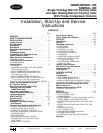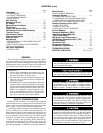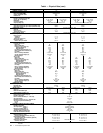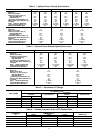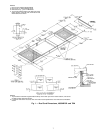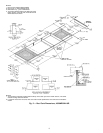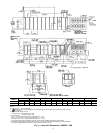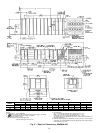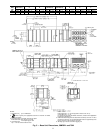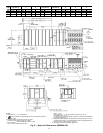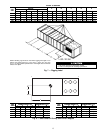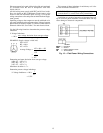
INSTALLATION
Jobsite Survey —
Complete the following checks be-
fore installation.
1. Consult local building codes and the NEC (National
Electrical Code) (ANSI/NFPA [National Fire Protection
Association] 70) for special installation requirements.
2. Determine unit location (from project plans) or select unit
location.
3. Check for possible overhead obstructions which may in-
terfere with unit lifting or rigging.
Do not lift unit with forklift truck. Move unit with
overhead rigging only.
Unit Placement — Inspect unit for transportation dam-
age. File claim with transportation agency.
Provide clearance around and above unit for airflow, safety,
and service access. Do not restrict top (area above con-
denser fans) in any way. Allow at least 6 ft on all sides for
rated performance, code compliance, and service.
Check unit dimensional drawings for unit arrangement and
minimum performance and service clearances.
Do not install unit in an indoor location. Do not locate air
inlets near exhaust vents or other sources of contaminated
air.
On units equipped with power exhaust option, high
velocity air is exhausted out the hood. Unit should be
positioned with at least 10 ft clearance between the exhaust
hood and any obstruction.Although unit isweatherproof, guard
against water from higher level runoff and overhangs.
Level by using unit frame as a reference. Physical data is
shown in Tables 1-4.
Roof Mount — Check building codes for weight distri-
bution requirements. Unit weight is shown in Table 1. Unit
may be mounted on class A, B, or C roofing material.
ROOF CURB — Assemble and install as described in in-
structions shipped with the accessory. Accessory roof curb
and information required to field fabricate a roof curb is shown
in Fig. 1 and 2. Install insulation, cant strips, roofing, and
counter flashing as required. For unit condensate drain to func-
tion properly, curb must be level or within tolerances shown
in Fig. 1 and 2.
STEEL BEAMS — If roof curb is not used, support unit
with steel beams along its entire length and then support steel
as required. As a minimum, unit must be supported across
its width at each lifting lug location.
Slab Mount — Provide a level concrete slab that ex-
tends beyond unit cabinet at least 6 inches. Make a slab 8 in.
thick with 4 in. above grade. Use gravel apron in front of
condenser coil air inlet to prevent grass and foliage from ob-
structing airflow. Ensure that slab is of sufficient height to
allow for 7-in. condensate trap.
Field-Fabricated Ductwork — Units are designed for
vertical supply/return only. Field-fabricated ductwork should
be attached to the roof curb. Supply and return duct dimen-
sions are shown in Fig. 1-6.
To attach ductwork to roof curb, insert duct approxi-
mately 10 to 11 in. up into roof curb. Connect ductwork to
14-gage roof curb material with sheet metal screws driven
from inside of the duct.
Secure all ducts to the building structure, using flexible
duct connectors between roof curb andducts as required. Ducts
passing through an unconditioned space must be insulated
and covered with a vapor barrier. Outlet grilles must not lie
directly below unit discharge. The return duct must have a
90-degree elbow before opening into the building space if
unit is equipped with power exhaust.
Design supply duct strong enough to handle expected static
pressures.
For vertical supply and return units, tools or parts could
drop into ductwork and cause an injury. Install 90 de-
gree turns in the supply and return ductwork between
the unit and the conditioned space. If a 90 degree elbow
cannot be installed, then grilles of sufficient strength and
density should be installed to prevent objects from fall-
ing into the conditioned space.
Rigging — Do not drop unit; keep upright. Use spreader
bars over unit to prevent sling or cable damage. Leave con-
denser coil shipping protection in place while rigging to
prevent coil damage. All lifting lugs MUST be used when
lifting unit.
Level by using unit frame as a reference. See Fig. 7 for
information. Unit and accessory weights are shown in
Tables 1-4. Weight distribution and center of gravity can be
found in Fig. 8.
Condensate Drains — The condensate drain connec-
tion is a 1
1
⁄
2
-in. NPT pipe connection located on the right
hand side of the unit. See Fig. 9.
NOTE: Use a trap of at least 7-in. deep.
Condenser Coil Shipping Covers — Remove and
discard.
Install Outdoor Hoods
1. Outdoor-air hoods are shipped bolted to the unit in a ship-
ping position. To open hoods, remove the 3 holddown
bars holding the air hood in shipping position. See
Fig. 10.
2. Lift up the highest hood top and swing out hood sides to
form the outside frame of the air hood. Fasten hood top
to hood sides at middle andtop holes only, using two screws
on each side. See Fig. 11.
3. Remove the bottom hood block-off plate and set aside.
4. Swing up second hood (from the top of unit) into place
and fasten to hood sides with screws provided using up-
per hole only.
5. Swing up third hood (from the top of unit) into place and
fasten to hood sides with screws provided using upper
hole only.
6. Swing up fourth hood (bottom hood) into place. Before
fastening hood to hood sides, swing down bottom filter
rack. Fasten hood to hood sides with screws provided us-
ing upper hole only.
7. Attach block off plate removed from Step 3.
8. Clip wire tie holding filter track. Swing filter track into
position and fasten to hood sides using screws provided.
Repeat until all 4 filter racks have been installed.
9. Apply a bead of RTV or similar sealant to corner of each
hood at pivot point to prevent water leaks.
Copy continues on page 14.
3



